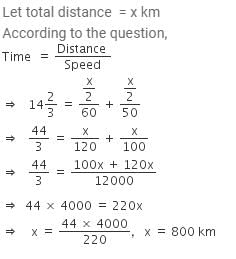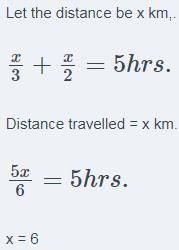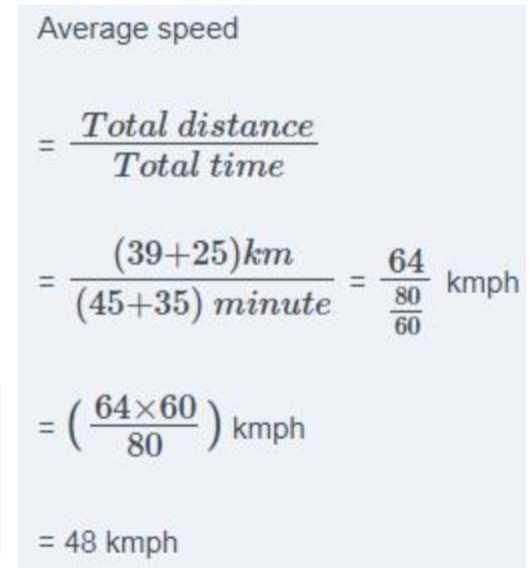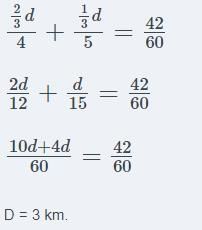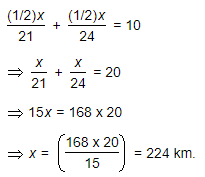All Exams >
CLAT >
Weekly Test for CLAT UG >
All Questions
All questions of Week 21 for CLAT Exam
Train – A crosses a stationary train –B in 35 seconds and a pole in 14 seconds with the same speed. The length of the train – A is 280 meters. What is the length of the stationary train – B?- a)360 meters
- b)480 meters
- c)400 meters
- d)None of these
Correct answer is option 'D'. Can you explain this answer?
Train – A crosses a stationary train –B in 35 seconds and a pole in 14 seconds with the same speed. The length of the train – A is 280 meters. What is the length of the stationary train – B?
a)
360 meters
b)
480 meters
c)
400 meters
d)
None of these
|
|
Anaya Patel answered |
Let the length of train B be x metre
∴ Speed of train A
∴ Speed of train A
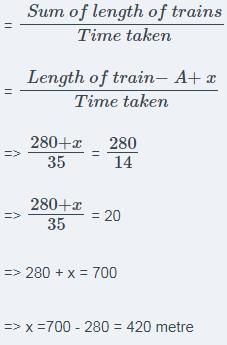
Two cyclists A and B start from the same place at the same time, one going towards north at 18 km/hr and other going towards south at 20 km/hr. What time will they take to be 95 km apart?- a)4 hrs 30 min
- b)4 hrs 45 min
- c)5 hrs 16 min
- d)2 hrs 30 min
Correct answer is option 'D'. Can you explain this answer?
Two cyclists A and B start from the same place at the same time, one going towards north at 18 km/hr and other going towards south at 20 km/hr. What time will they take to be 95 km apart?
a)
4 hrs 30 min
b)
4 hrs 45 min
c)
5 hrs 16 min
d)
2 hrs 30 min

|
Shanaya Sharma answered |
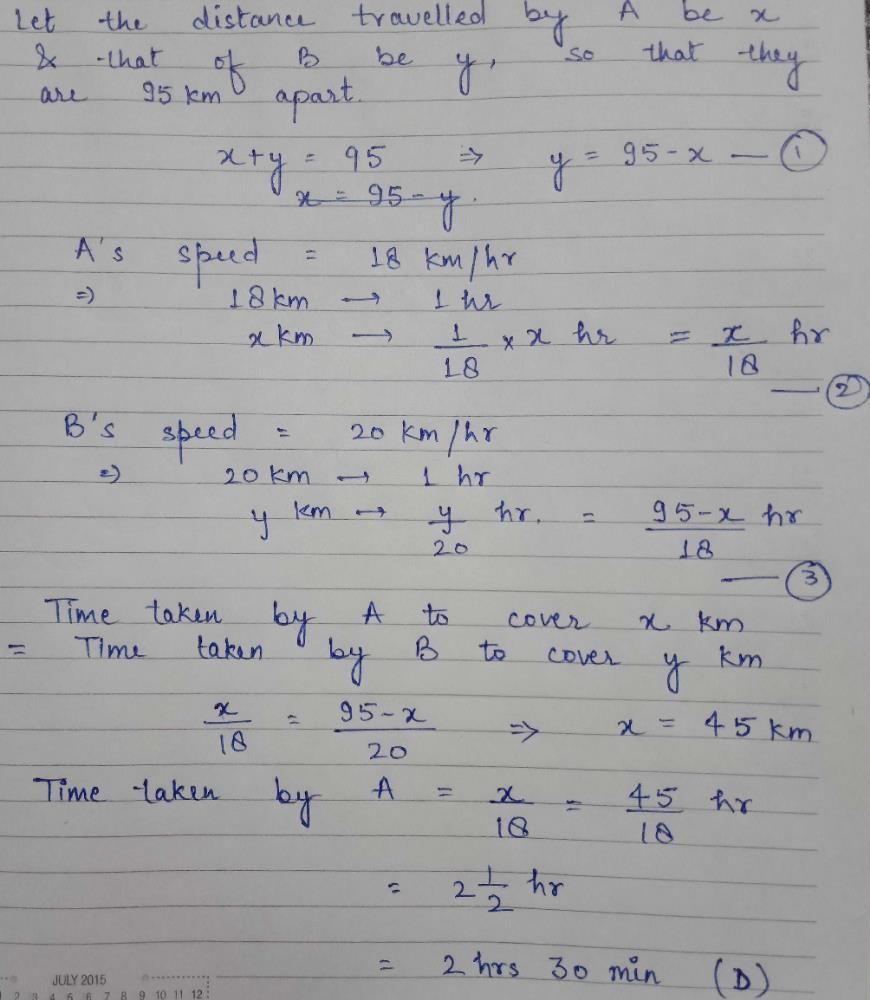
A certain distance is covered at a certain speed. If half of this distance is covered in double the time, the ratio of the two speeds is- a)4 :1
- b)1 : 4
- c)2 : 1
- d)1 : 2
Correct answer is option 'A'. Can you explain this answer?
A certain distance is covered at a certain speed. If half of this distance is covered in double the time, the ratio of the two speeds is
a)
4 :1
b)
1 : 4
c)
2 : 1
d)
1 : 2
|
|
Prakhya Shrivastava answered |
Let distance 'x' is covered by speed 'S' in time 't'
i.e. S=x/t ...(1)
Now if new speed is 's' which is covered half of distance (x) in double time (t)
i.e. distance for speed 's' = x/2 (half of actual distance)
and time taken by speed 's' = 2t (double of actual time)
Then, s = (x/2)/2t = (1/4)×(x/t)
Putting x/t = S from eqn. (1)
=> s = (1/4)×S
=> S:s = 4:1
i.e. S=x/t ...(1)
Now if new speed is 's' which is covered half of distance (x) in double time (t)
i.e. distance for speed 's' = x/2 (half of actual distance)
and time taken by speed 's' = 2t (double of actual time)
Then, s = (x/2)/2t = (1/4)×(x/t)
Putting x/t = S from eqn. (1)
=> s = (1/4)×S
=> S:s = 4:1
A person crosses a 600 m long street in 5 minutes. What is his speed in km per hour?- a)3.6
- b)7.2
- c)8.4
- d)10
Correct answer is option 'B'. Can you explain this answer?
A person crosses a 600 m long street in 5 minutes. What is his speed in km per hour?
a)
3.6
b)
7.2
c)
8.4
d)
10
|
|
Prakhya Shrivastava answered |
Given
Distance = 600m = 0.6km
and time =5min = 1/12 hour
by formula
Speed = distance/time
=> Speed = 0.6/(1/12) km/hour
=> Speed = 0.6×12 km/hour
=> Speed = 7.2km/hour
Thus option B is correct
A 320 meter long train moving with an average speed of 120 km/hr crosses a platform in 24 seconds. A man crosses the same platform in 4 minutes. What is the speed of man in meter/second?- a)2.4
- b)1.5
- c)1.6
- d)2.0
Correct answer is option 'C'. Can you explain this answer?
A 320 meter long train moving with an average speed of 120 km/hr crosses a platform in 24 seconds. A man crosses the same platform in 4 minutes. What is the speed of man in meter/second?
a)
2.4
b)
1.5
c)
1.6
d)
2.0
|
|
Anaya Patel answered |
Speed of train = 120 kmph
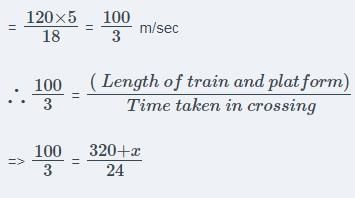
Where x = length of platform
 = 320 + x
= 320 + x
 = 320 + x
= 320 + x800 = 320 +x
x = 800 - 320 = 480 m
∴ Man's speed = 

In a flight of 600 km, an aircraft was slowed down due to bad weather. Its average speed for the trip was reduced by 200 km/hr and the time of flight increased by 30 minutes. The duration of the flight is:- a)1 hour
- b)2 hours
- c)3 hours
- d)4 hours
Correct answer is option 'A'. Can you explain this answer?
In a flight of 600 km, an aircraft was slowed down due to bad weather. Its average speed for the trip was reduced by 200 km/hr and the time of flight increased by 30 minutes. The duration of the flight is:
a)
1 hour
b)
2 hours
c)
3 hours
d)
4 hours
|
|
Siddhi Sharma answered |
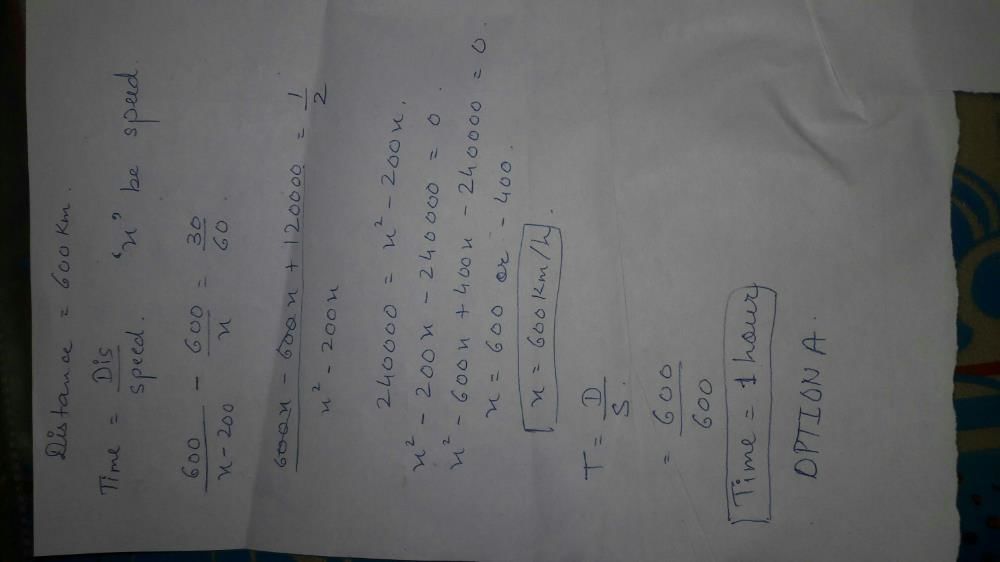
A 300 meter long train moving with an average speed of 126 km/hr crosses a platform in 24 seconds. A man crosses the same platform in 5 minutes. What is the speed of man in meter / second?- a)1.8m/s
- b)1.2m/s
- c)1.5m/s
- d)Cannot be determined
Correct answer is option 'A'. Can you explain this answer?
A 300 meter long train moving with an average speed of 126 km/hr crosses a platform in 24 seconds. A man crosses the same platform in 5 minutes. What is the speed of man in meter / second?
a)
1.8m/s
b)
1.2m/s
c)
1.5m/s
d)
Cannot be determined
|
|
Wahid Khan answered |
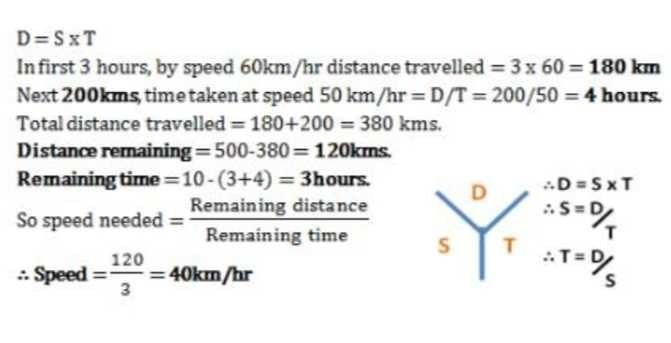
A train can travel 50% faster than a car. Both start from point A at the same time and reach point B 75 kms away from A at the same time. On the way, however, the train lost about 12.5 minutes while stopping at the stations. The speed of the car is:- a)100 kmph
- b)110 kmph
- c)120 kmph
- d)130 kmph
Correct answer is option 'C'. Can you explain this answer?
A train can travel 50% faster than a car. Both start from point A at the same time and reach point B 75 kms away from A at the same time. On the way, however, the train lost about 12.5 minutes while stopping at the stations. The speed of the car is:
a)
100 kmph
b)
110 kmph
c)
120 kmph
d)
130 kmph

|
Niladrita Chakraborty answered |
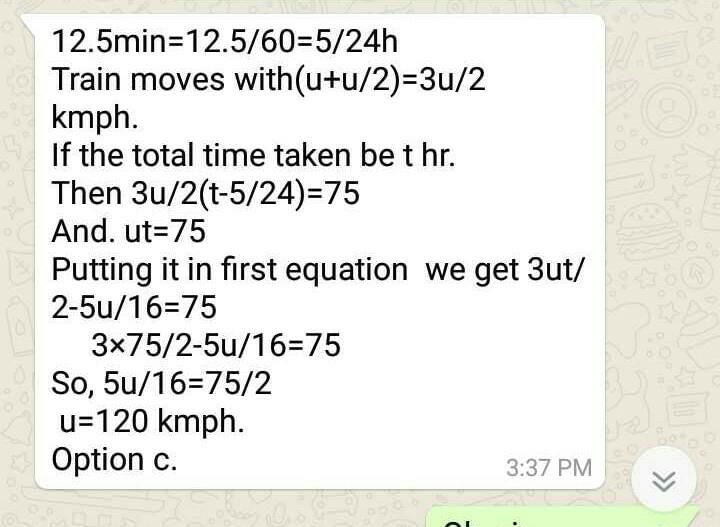
Suresh travelled 1200 km by air which formed (2/5) of his trip. One third of the whole trip, he travelled by car and the rest of the journey he performed by train. The distance travelled by trains was- a)1600 km
- b)800 km
- c)1800 km
- d)480 km
Correct answer is option 'B'. Can you explain this answer?
Suresh travelled 1200 km by air which formed (2/5) of his trip. One third of the whole trip, he travelled by car and the rest of the journey he performed by train. The distance travelled by trains was
a)
1600 km
b)
800 km
c)
1800 km
d)
480 km
|
|
Dia Mehta answered |
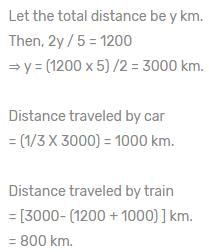
Convert the following sentences into simple past passive.
Nobody helped him.
Correct answer is 'Simple Past Passive voice is :He was not helped by anybody.'. Can you explain this answer?
Convert the following sentences into simple past passive.
Nobody helped him.
Nobody helped him.
|
|
Meera Rana answered |
Simple Past Passive voice is :
He was not helped by anybody.
He was not helped by anybody.
Study to learn active and passive voice quiz questions to attempt multiple choice questions based test. Q. Why do they take you on lunch?- a)Why are you taken by them on lunch?
- b)Why do you taken by them on lunch?
- c)Why is you taken by them on lunch.
- d)None of the above
Correct answer is option 'A'. Can you explain this answer?
Study to learn active and passive voice quiz questions to attempt multiple choice questions based test.
Q. Why do they take you on lunch?
a)
Why are you taken by them on lunch?
b)
Why do you taken by them on lunch?
c)
Why is you taken by them on lunch.
d)
None of the above
|
|
Meera Rana answered |
The correct passive voice is :
Why are you taken by them on lunch?
Why are you taken by them on lunch?
Can you lay down your life for home land?- a)Could your life lay down by you for homeland?
- b)Can your life been laid down by you for home land?
- c)Can your life be laid down by you for homeland?
- d)Could your life been laid down by you for your homeland?
Correct answer is option 'C'. Can you explain this answer?
Can you lay down your life for home land?
a)
Could your life lay down by you for homeland?
b)
Can your life been laid down by you for home land?
c)
Can your life be laid down by you for homeland?
d)
Could your life been laid down by you for your homeland?

|
Talent Skill Learning answered |
answer is C
Can your life be laid down by you for homeland?
I will not cheat them.- a)They will not cheated by me.
- b)They will not been cheated by me.
- c)They will being cheated by me.
- d)They will not be cheated by me.
Correct answer is option 'D'. Can you explain this answer?
I will not cheat them.
a)
They will not cheated by me.
b)
They will not been cheated by me.
c)
They will being cheated by me.
d)
They will not be cheated by me.
|
|
Meera Rana answered |
Passive voice is :
They will not be cheated by me.
They will not be cheated by me.
If a boy takes as much time in running 10 m as a car takes in covering 25 m, the distance covered by the boy during the time the car covers 1 km is- a)400 m
- b)40 m
- c)250 m
- d)650 m
Correct answer is option 'A'. Can you explain this answer?
If a boy takes as much time in running 10 m as a car takes in covering 25 m, the distance covered by the boy during the time the car covers 1 km is
a)
400 m
b)
40 m
c)
250 m
d)
650 m
|
|
Shanaya Sharma answered |
Let in t time , boy covers 10m and car covers 25m.
for car , 1m distance is covered in t/25
Then , 1km is covered in = (t/25)*1000 = 40t
In t time , boy covers = 10m
So in 40t time , boy covers = 40*10=400m
Correct option is a) 400m
for car , 1m distance is covered in t/25
Then , 1km is covered in = (t/25)*1000 = 40t
In t time , boy covers = 10m
So in 40t time , boy covers = 40*10=400m
Correct option is a) 400m
Train – A crosses a pole in 25 seconds and another Train B crosses a pole in 1 minute and 15 seconds. Length of train A is half length of train B. what is the respective ratio between the speed of train A and Train – B?- a)3 : 2
- b)3 : 4
- c)4 : 3
- d)Cannot be determined
Correct answer is option 'A'. Can you explain this answer?
Train – A crosses a pole in 25 seconds and another Train B crosses a pole in 1 minute and 15 seconds. Length of train A is half length of train B. what is the respective ratio between the speed of train A and Train – B?
a)
3 : 2
b)
3 : 4
c)
4 : 3
d)
Cannot be determined
|
|
Wahid Khan answered |
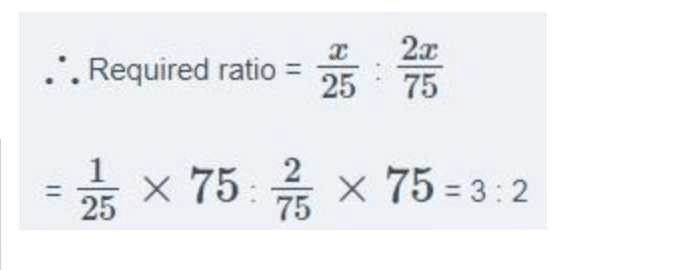
Train – A crosses a pole in 33 seconds and another Train –B crosses a pole in 55 seconds. Length of Train-A is three-fourth of Train-B. What is the respective ratio between the speed of Train–A and Train – B?- a)5 : 11
- b)5 : 4
- c)11 : 3
- d)Cannot be determined
Correct answer is option 'B'. Can you explain this answer?
Train – A crosses a pole in 33 seconds and another Train –B crosses a pole in 55 seconds. Length of Train-A is three-fourth of Train-B. What is the respective ratio between the speed of Train–A and Train – B?
a)
5 : 11
b)
5 : 4
c)
11 : 3
d)
Cannot be determined

|
Anand Singh answered |
Distance = Speed/Timespeed = distanc... moree/timeAccording to questionTrain A= 3/4 Train B (Distance or Length)Speed of Train A =( (3/4)Distance)/33Speed of Train B = Distance/55Ratio =( (3/4)Distance)/33 ÷ Distance/55 = 5/4 = 5:4
Will they attend meeting?- a)Will the meeting attended by them?
- b)Will the meeting being attended by them?
- c)Will the meeting be attended by them
- d)Would the meeting attend by them?
Correct answer is option 'C'. Can you explain this answer?
Will they attend meeting?
a)
Will the meeting attended by them?
b)
Will the meeting being attended by them?
c)
Will the meeting be attended by them
d)
Would the meeting attend by them?
|
|
Meera Rana answered |
" Will the meeting be attended by them? "
There is an error of (?) Question mark.
Will she oppose them?- a)Will she oppose them?
- b)Will they opposed by her?
- c)Will they be opposed by her?
- d)Will they been opposed by her?
Correct answer is option 'C'. Can you explain this answer?
Will she oppose them?
a)
Will she oppose them?
b)
Will they opposed by her?
c)
Will they be opposed by her?
d)
Will they been opposed by her?
|
|
Meera Rana answered |
‘Them’ is the object, so it becomes the subject, ‘they’.
The subject, ‘she’, becomes the agent - ‘by her’.
The verb is ‘will … oppose’. The tense is future simple
So, ‘will they be opposed?’
The subject, ‘she’, becomes the agent - ‘by her’.
The verb is ‘will … oppose’. The tense is future simple
So, ‘will they be opposed?’
Will they be opposed by her?
Convert the following sentences into simple past passive.
1. The company chose me to present the project.
Correct answer is 'I was chosen by the company to present the project.'. Can you explain this answer?
Convert the following sentences into simple past passive.
1. The company chose me to present the project.
1. The company chose me to present the project.
|
|
Meera Rana answered |
I was chosen by the company to present the project.
Convert the following sentences into simple past passive.
The students converted each sentence to passive.Correct answer is 'Each sentence was converted to passive by the students'. Can you explain this answer?
Convert the following sentences into simple past passive.
The students converted each sentence to passive.
The students converted each sentence to passive.
|
|
Meera Rana answered |
The students converted each sentence to passive.
( In simple past passive)
Each sentence was converted to passive by the students.
( In simple past passive)
Each sentence was converted to passive by the students.
Which of the following states has international borders with three countries?
- a)West Bengal
- b)Sikkim
- c)Mizoram
- d)Kerala
Correct answer is option 'B'. Can you explain this answer?
Which of the following states has international borders with three countries?
a)
West Bengal
b)
Sikkim
c)
Mizoram
d)
Kerala
|
|
Eshaan Kapoor answered |
Sikkim is a landlocked Indian state located in the Himalayan Mountains. The state borders Nepal to the west, China's Tibet Autonomous Region to the north and east, and Bhutan to the southeast. The Indian state of West Bengal lies to the south.
A 280 meters long train travelling at a uniform speed, crosses a platform in 60 seconds and a man standing on the platform in 20 seconds. What is the length of the platform?- a)640 meters
- b)420 meters
- c)280 meters
- d) None of these
Correct answer is option 'D'. Can you explain this answer?
A 280 meters long train travelling at a uniform speed, crosses a platform in 60 seconds and a man standing on the platform in 20 seconds. What is the length of the platform?
a)
640 meters
b)
420 meters
c)
280 meters
d)
None of these
|
|
Wahid Khan answered |
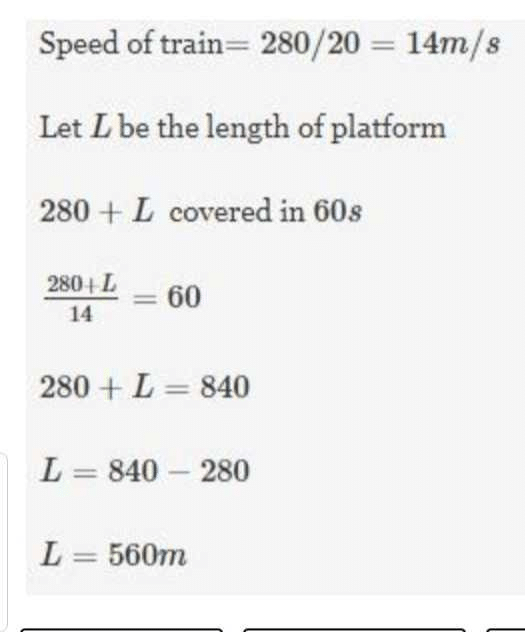
If the 20th of February, 1995 was Saturday, then the number of Mondays in that month is- a)One
- b)Two
- c)Three
- d)Four
- e)None of these
Correct answer is option 'D'. Can you explain this answer?
If the 20th of February, 1995 was Saturday, then the number of Mondays in that month is
a)
One
b)
Two
c)
Three
d)
Four
e)
None of these

|
Deepika Banerjee answered |
20 => Saturday then 6, 13, 27 also Saturday Then 4 Mondays in that month
An aeroplane flies with an average speed of 756 km/hr. A helicopter takes 48 hours to cover twice the distance covered by aeroplane in 9 hours. How much distance will the helicopter cover in 18 hours? (assuming that flights are non-stop and moving with uniform speed)- a)5014 km
- b)5140 km
- c)5130 km
- d)5103 km
Correct answer is option 'D'. Can you explain this answer?
An aeroplane flies with an average speed of 756 km/hr. A helicopter takes 48 hours to cover twice the distance covered by aeroplane in 9 hours. How much distance will the helicopter cover in 18 hours? (assuming that flights are non-stop and moving with uniform speed)
a)
5014 km
b)
5140 km
c)
5130 km
d)
5103 km
|
|
Wahid Khan answered |
Distance covered by aeroplane in 18 hours =speed xtime
=756x18
=13608km
the distance covered by helicopter in 48 hours=twice distance of the aeroplane
=2x13608
=27216km
speed of helicopter
=27216/48=567kmper hour
distance covered by helicopter in 9 hours
=567x9
=5103km
=756x18
=13608km
the distance covered by helicopter in 48 hours=twice distance of the aeroplane
=2x13608
=27216km
speed of helicopter
=27216/48=567kmper hour
distance covered by helicopter in 9 hours
=567x9
=5103km
Which of the following states does not border on Myanmar? - a)Arunachal Pradesh
- b)Nagaland
- c)Meghalaya
- d)Mizoram
Correct answer is option 'C'. Can you explain this answer?
Which of the following states does not border on Myanmar?
a)
Arunachal Pradesh
b)
Nagaland
c)
Meghalaya
d)
Mizoram
|
|
Dia Mehta answered |
Meghalaya is bounded on the north by Assam and by Bangladesh on the south.
‘Monism’ denotes that International Law and State Law____________?- a)represent two entirely distinct legal system
- b)are concomitant aspects of the one system
- c)are not enforceable
- d)are not binding
Correct answer is option 'B'. Can you explain this answer?
‘Monism’ denotes that International Law and State Law____________?
a)
represent two entirely distinct legal system
b)
are concomitant aspects of the one system
c)
are not enforceable
d)
are not binding
|
|
Mohit Sharma answered |
The human immune system is a complex network of cells, tissues, and organs that work together to defend the body against harmful pathogens such as viruses, bacteria, and parasites. It is an essential part of our body's defense mechanisms and plays a crucial role in maintaining overall health.
The immune system functions by recognizing and attacking foreign substances or antigens that enter the body. These antigens can be found on the surface of pathogens or on cells that have been infected by them. When the immune system detects an antigen, it triggers a cascade of events to eliminate the threat.
There are two main components of the immune system: the innate immune system and the adaptive immune system. The innate immune system is the body's first line of defense and provides immediate, non-specific protection against a wide range of pathogens. It includes physical barriers, such as the skin and mucous membranes, as well as various cells and proteins that can recognize and destroy foreign invaders.
The adaptive immune system, on the other hand, provides a more specific and targeted response to pathogens. It is characterized by the presence of specialized cells called lymphocytes, which can recognize and remember specific antigens. When a lymphocyte encounters an antigen it has previously encountered, it triggers a rapid and specific response to eliminate the threat.
The immune system also relies on a variety of other cells and proteins to carry out its functions. These include phagocytes, which engulf and destroy pathogens, as well as antibodies, which are proteins that can bind to specific antigens and mark them for destruction.
Overall, the immune system is a highly sophisticated and coordinated network that works tirelessly to protect the body from harmful pathogens. It is constantly adapting and evolving to recognize and eliminate new threats, and plays a crucial role in maintaining overall health and well-being.
The immune system functions by recognizing and attacking foreign substances or antigens that enter the body. These antigens can be found on the surface of pathogens or on cells that have been infected by them. When the immune system detects an antigen, it triggers a cascade of events to eliminate the threat.
There are two main components of the immune system: the innate immune system and the adaptive immune system. The innate immune system is the body's first line of defense and provides immediate, non-specific protection against a wide range of pathogens. It includes physical barriers, such as the skin and mucous membranes, as well as various cells and proteins that can recognize and destroy foreign invaders.
The adaptive immune system, on the other hand, provides a more specific and targeted response to pathogens. It is characterized by the presence of specialized cells called lymphocytes, which can recognize and remember specific antigens. When a lymphocyte encounters an antigen it has previously encountered, it triggers a rapid and specific response to eliminate the threat.
The immune system also relies on a variety of other cells and proteins to carry out its functions. These include phagocytes, which engulf and destroy pathogens, as well as antibodies, which are proteins that can bind to specific antigens and mark them for destruction.
Overall, the immune system is a highly sophisticated and coordinated network that works tirelessly to protect the body from harmful pathogens. It is constantly adapting and evolving to recognize and eliminate new threats, and plays a crucial role in maintaining overall health and well-being.
The atomic power station in Rajasthan is situated at : - a)Pokhran
- b)Suratgarh
- c)Rawatbhata
- d)Chittorgarh
Correct answer is option 'C'. Can you explain this answer?
The atomic power station in Rajasthan is situated at :
a)
Pokhran
b)
Suratgarh
c)
Rawatbhata
d)
Chittorgarh
|
|
Roshni shukla answered |
Overview of Atomic Power Stations in Rajasthan
Rajasthan is home to several significant atomic power stations, contributing to the country's energy needs. Among these, the Rawatbhata Atomic Power Station (RAPS) is the most notable.
Location of Rawatbhata
- Rawatbhata is located near the city of Kota in Rajasthan.
- It is positioned approximately 70 kilometers from the state capital, Jaipur.
Importance of Rawatbhata Atomic Power Station
- RAPS plays a crucial role in generating electricity using nuclear power, which is essential for meeting the energy demands of the state and the country.
- The power station has multiple reactors, contributing significantly to the national grid.
Comparison with Other Locations
- Pokhran: Known for its nuclear test site, it is not an atomic power station.
- Suratgarh: This site houses a thermal power station, not a nuclear one.
- Chittorgarh: While significant in its own right, it does not host an atomic power facility.
Conclusion
Given the above details, the correct answer to the question regarding the location of the atomic power station in Rajasthan is indeed option 'C' - Rawatbhata. This facility underscores the state's contribution to India's nuclear energy landscape, making it a pivotal site for power generation.
Rajasthan is home to several significant atomic power stations, contributing to the country's energy needs. Among these, the Rawatbhata Atomic Power Station (RAPS) is the most notable.
Location of Rawatbhata
- Rawatbhata is located near the city of Kota in Rajasthan.
- It is positioned approximately 70 kilometers from the state capital, Jaipur.
Importance of Rawatbhata Atomic Power Station
- RAPS plays a crucial role in generating electricity using nuclear power, which is essential for meeting the energy demands of the state and the country.
- The power station has multiple reactors, contributing significantly to the national grid.
Comparison with Other Locations
- Pokhran: Known for its nuclear test site, it is not an atomic power station.
- Suratgarh: This site houses a thermal power station, not a nuclear one.
- Chittorgarh: While significant in its own right, it does not host an atomic power facility.
Conclusion
Given the above details, the correct answer to the question regarding the location of the atomic power station in Rajasthan is indeed option 'C' - Rawatbhata. This facility underscores the state's contribution to India's nuclear energy landscape, making it a pivotal site for power generation.
Which national highway connects Delhi and Kolkata via Mathura and Varanasi? - a)NH4
- b)NH2
- c)NH10
- d)NH6
Correct answer is option 'B'. Can you explain this answer?
Which national highway connects Delhi and Kolkata via Mathura and Varanasi?
a)
NH4
b)
NH2
c)
NH10
d)
NH6
|
|
Dia Mehta answered |
National Highway 2, commonly referred as Delhi-Kolkata Road, is a busy Indian National Highway that runs through the states of Delhi, Haryana, Uttar Pradesh, Bihar, Jharkhand, and West Bengal. It constitutes a major portion of the historical Grand Trunk Road along with NH 91 and NH 1 in India.
According to Ram’s mother, Ram reached Delhi after 13 January 2013 ,but before 19 January 2013.According to Ram ,He reached Delhi after 16 January 2013 but before 22 January 2013.If both of them are correct,then on which date did Ram reached Delhi?- a)19 January 2013
- b)18 January 2013
- c)17 January 2013
- d)16 January 2013
- e)Cannot be determined
Correct answer is option 'E'. Can you explain this answer?
According to Ram’s mother, Ram reached Delhi after 13 January 2013 ,but before 19 January 2013.According to Ram ,He reached Delhi after 16 January 2013 but before 22 January 2013.If both of them are correct,then on which date did Ram reached Delhi?
a)
19 January 2013
b)
18 January 2013
c)
17 January 2013
d)
16 January 2013
e)
Cannot be determined

|
Deepika Banerjee answered |
Mother 14 15 16 17 18 Ram 17 18 19 20 21. Hence 2 dated are common we cannot say particular date
Majuli, the largest river island in the world, lies in the state of –- a)Arunachal Pradesh
- b)Assam
- c)Tripura
- d)Mizoram
Correct answer is option 'B'. Can you explain this answer?
Majuli, the largest river island in the world, lies in the state of –
a)
Arunachal Pradesh
b)
Assam
c)
Tripura
d)
Mizoram
|
|
Dia Mehta answered |
Majuli is a large river island in the Brahmaputra river, in Assam. It is the largest river island in the world. The island is formed by the Brahmaputra River in the south and the Kherkutia Xuti, an anabranch of the Brahmaputra, joined by the Subansiri River in the north. Majuli island is accessible by ferries from the City of Jorhat. The island is about 200 kilometres east from the state's largest city — Guwahati. The island was formed due to course changes by the river Brahmaputra and its tributaries, mainly the Lohit. Majuli is also the abode of the Assamese neo-Vaishnavite culture.
If the 30th December 2014 was Tuesday, what was the day day on 28 February, 2015?- a)Tuesday
- b)Wednesday
- c)Thursday
- d)Friday
- e)None of these
Correct answer is option 'B'. Can you explain this answer?
If the 30th December 2014 was Tuesday, what was the day day on 28 February, 2015?
a)
Tuesday
b)
Wednesday
c)
Thursday
d)
Friday
e)
None of these

|
Navya Reddy answered |
30th December, 2014 was Tuesday. So, 6th, 13th, 20th, 27th Jan were all Tuesdays. 28 Feb – Wednesday
. If Monday falls on 5th of month, then which day will fall three days after the 26th ?- a)Monday
- b)Tuesday
- c)Wedenesday
- d)Thursday
- e)None of these
Correct answer is option 'D'. Can you explain this answer?
. If Monday falls on 5th of month, then which day will fall three days after the 26th ?
a)
Monday
b)
Tuesday
c)
Wedenesday
d)
Thursday
e)
None of these

|
Deepika Banerjee answered |
5th is Monday, then 12, 19, 26th also Monday Then 3 days after is 29th, which is Thursday
On 8th May, 1999 Saturday falls. What day of the week was it on 10th May, 2000?- a)Wedneday
- b)Saturday
- c)Thursday
- d)Monday
- e)None of these
Correct answer is option 'A'. Can you explain this answer?
On 8th May, 1999 Saturday falls. What day of the week was it on 10th May, 2000?
a)
Wedneday
b)
Saturday
c)
Thursday
d)
Monday
e)
None of these

|
Deepika Banerjee answered |
8th May, 1999 =>Saturday 2000=> leap year 2 odd day 8th May, 1999 => Monday 10 May, 1999=> Wednesday
Which one of the following propositions would be correct according to the Vienna Convention on the Law of Treaties, 1960?- a)The reservation and the objection cancel each other and all the provisions of the treaty will apply to all parties
- b)The provisions of the treaty to which the reservation applies, shall not apply between the reserving state and the objecting state unless the objecting state specifically objects to the entry into force of the treaty as between the two states
- c)The reservation and the objection prevent the treaty from coming into force in respect of all of its parties
- d)The objection invalidates the reservation, and the reserving state ceases to be a party to the treaty.
Correct answer is option 'B'. Can you explain this answer?
Which one of the following propositions would be correct according to the Vienna Convention on the Law of Treaties, 1960?
a)
The reservation and the objection cancel each other and all the provisions of the treaty will apply to all parties
b)
The provisions of the treaty to which the reservation applies, shall not apply between the reserving state and the objecting state unless the objecting state specifically objects to the entry into force of the treaty as between the two states
c)
The reservation and the objection prevent the treaty from coming into force in respect of all of its parties
d)
The objection invalidates the reservation, and the reserving state ceases to be a party to the treaty.
|
|
Geeta jain answered |
According to the Vienna Convention on the Law of Treaties, 1969, the correct proposition is option 'B': The provisions of the treaty to which the reservation applies shall not apply between the reserving state and the objecting state unless the objecting state specifically objects to the entry into force of the treaty as between the two states.
Explanation:
The Vienna Convention on the Law of Treaties is an international treaty that sets out the rules governing the formation, interpretation, and termination of treaties. It provides a framework for the rights and obligations of states in relation to treaties.
When a state makes a reservation to a treaty, it effectively modifies its obligations under that treaty. The reservation allows the state to exclude or modify the legal effect of certain provisions of the treaty in their application to that state. However, the reservation can only be made if it is not prohibited by the treaty and is not incompatible with the object and purpose of the treaty.
When a state objects to a reservation made by another state, it means that it disagrees with the reservation and does not consider it valid. The objection can be made if the reservation is considered to be incompatible with the object and purpose of the treaty.
According to the Vienna Convention, when a state makes a reservation to a treaty and another state objects to that reservation, the provisions of the treaty to which the reservation applies shall not apply between the reserving state and the objecting state unless the objecting state specifically objects to the entry into force of the treaty as between the two states.
In other words, the objection by the objecting state prevents the specific provisions of the treaty to which the reservation applies from being applicable between the two states. However, if the objecting state does not object to the entry into force of the treaty as between the two states, then the treaty provisions will apply to the reserving state and the objecting state.
This provision ensures that both the reserving state and the objecting state have a say in the application of the treaty provisions, while also safeguarding the object and purpose of the treaty. It allows for a balance between the rights and obligations of the states involved.
Explanation:
The Vienna Convention on the Law of Treaties is an international treaty that sets out the rules governing the formation, interpretation, and termination of treaties. It provides a framework for the rights and obligations of states in relation to treaties.
When a state makes a reservation to a treaty, it effectively modifies its obligations under that treaty. The reservation allows the state to exclude or modify the legal effect of certain provisions of the treaty in their application to that state. However, the reservation can only be made if it is not prohibited by the treaty and is not incompatible with the object and purpose of the treaty.
When a state objects to a reservation made by another state, it means that it disagrees with the reservation and does not consider it valid. The objection can be made if the reservation is considered to be incompatible with the object and purpose of the treaty.
According to the Vienna Convention, when a state makes a reservation to a treaty and another state objects to that reservation, the provisions of the treaty to which the reservation applies shall not apply between the reserving state and the objecting state unless the objecting state specifically objects to the entry into force of the treaty as between the two states.
In other words, the objection by the objecting state prevents the specific provisions of the treaty to which the reservation applies from being applicable between the two states. However, if the objecting state does not object to the entry into force of the treaty as between the two states, then the treaty provisions will apply to the reserving state and the objecting state.
This provision ensures that both the reserving state and the objecting state have a say in the application of the treaty provisions, while also safeguarding the object and purpose of the treaty. It allows for a balance between the rights and obligations of the states involved.
If first is November Tuesday then first December will be- a)Tuesday
- b)Wednesday
- c)Monday
- d)Thursday
- e)Friday
Correct answer is option 'D'. Can you explain this answer?
If first is November Tuesday then first December will be
a)
Tuesday
b)
Wednesday
c)
Monday
d)
Thursday
e)
Friday

|
Shanaya Dey answered |
Nov 1 – Tueday(Nov 8,15,22,29) Nov 30 – Wednesday then Dec 1st will be Thursday
A man performs 2/15 of the total journey by rail, 9/20 by tonga and the remaining 10 km on foot. His total journey is- a)15.6 km
- b)12.8 km
- c)16.4 km
- d)24 km
Correct answer is option 'D'. Can you explain this answer?
A man performs 2/15 of the total journey by rail, 9/20 by tonga and the remaining 10 km on foot. His total journey is
a)
15.6 km
b)
12.8 km
c)
16.4 km
d)
24 km

|
Prerna Sen answered |
Let the total journey of man be x km.
Then A/Q,
2/15 *x + 9/20*x + 10 = x
8x + 27x +600 / 60 = x
35x + 600 / 60 = x
5[7x + 120] / 60 = x
7x + 120/ 12 = x
7x + 120 = 12x
12x - 7x = 120
5x = 120
x = 24
Convert the following sentences into simple past passive.
Herman didn't take this speech seriously.Correct answer is 'This speech was not taken seriously by Herman'. Can you explain this answer?
Convert the following sentences into simple past passive.
Herman didn't take this speech seriously.
Herman didn't take this speech seriously.
|
|
Leela Iyer answered |
This speech was not taken seriously by Herman.
Some effort has been made to transform the status of an individual from the object to the subject of International Law. The first effort towards this was made after the________?- a)Treaty of Westphalia
- b)1815 Vienna Conference
- c)First World War
- d)Second World War
Correct answer is option 'D'. Can you explain this answer?
Some effort has been made to transform the status of an individual from the object to the subject of International Law. The first effort towards this was made after the________?
a)
Treaty of Westphalia
b)
1815 Vienna Conference
c)
First World War
d)
Second World War
|
|
Shounak Mukherjee answered |
The Transformation of the Status of an Individual to Subject of International Law
The status of an individual as a subject of International Law has been a result of a long and gradual process. The first effort towards this transformation was made after the Second World War.
The aftermath of the Second World War led to the establishment of the United Nations, which was based on the principle of the sovereign equality of all its members. The UN Charter recognized the importance of protecting human rights and fundamental freedoms for all individuals, without discrimination based on race, gender, religion, or other factors.
Significance of the Second World War:
The Second World War was a significant event in the history of international relations as it resulted in the deaths of millions of people, including civilians. The atrocities committed during the war brought attention to the need for international law to protect individuals from acts of aggression and violations of their human rights.
Impact of the Second World War on International Law:
The Second World War led to the development of new principles of international law, which recognized the importance of protecting individuals from acts of aggression and violations of their human rights.
The Nuremberg Trials, which were held after the war, established the principle of individual criminal responsibility for acts of aggression and crimes against humanity. This principle was later incorporated into the International Criminal Court's Rome Statute.
The Universal Declaration of Human Rights, adopted by the UN General Assembly in 1948, recognized the inherent dignity and inalienable rights of all individuals, regardless of their nationality, race, or religion. This declaration led to the development of international human rights law, which has become an integral part of contemporary international law.
Conclusion:
In conclusion, the Second World War was a turning point in the history of international law as it led to the recognition of the importance of protecting individuals from acts of aggression and violations of their human rights. The establishment of the UN and the development of new principles of international law paved the way for the transformation of the status of an individual from the object to the subject of international law.
The status of an individual as a subject of International Law has been a result of a long and gradual process. The first effort towards this transformation was made after the Second World War.
The aftermath of the Second World War led to the establishment of the United Nations, which was based on the principle of the sovereign equality of all its members. The UN Charter recognized the importance of protecting human rights and fundamental freedoms for all individuals, without discrimination based on race, gender, religion, or other factors.
Significance of the Second World War:
The Second World War was a significant event in the history of international relations as it resulted in the deaths of millions of people, including civilians. The atrocities committed during the war brought attention to the need for international law to protect individuals from acts of aggression and violations of their human rights.
Impact of the Second World War on International Law:
The Second World War led to the development of new principles of international law, which recognized the importance of protecting individuals from acts of aggression and violations of their human rights.
The Nuremberg Trials, which were held after the war, established the principle of individual criminal responsibility for acts of aggression and crimes against humanity. This principle was later incorporated into the International Criminal Court's Rome Statute.
The Universal Declaration of Human Rights, adopted by the UN General Assembly in 1948, recognized the inherent dignity and inalienable rights of all individuals, regardless of their nationality, race, or religion. This declaration led to the development of international human rights law, which has become an integral part of contemporary international law.
Conclusion:
In conclusion, the Second World War was a turning point in the history of international law as it led to the recognition of the importance of protecting individuals from acts of aggression and violations of their human rights. The establishment of the UN and the development of new principles of international law paved the way for the transformation of the status of an individual from the object to the subject of international law.
Who prepares the topographical maps of India? - a)Geological Survey of India
- b)Survey of India
- c)Defence Ministry
- d)Geographical Survey of India
Correct answer is option 'B'. Can you explain this answer?
Who prepares the topographical maps of India?
a)
Geological Survey of India
b)
Survey of India
c)
Defence Ministry
d)
Geographical Survey of India
|
|
Aryan Khanna answered |
For most part of India, topographic maps are available which are prepared by the Survey of India. To identify a map of a particular area, a map numbering system has been adopted by Survey of India.
Which State of India has the largest area? - a)Uttar Pradesh
- b)Madhya Pradesh
- c)Maharashtra
- d)Rajasthan
Correct answer is option 'D'. Can you explain this answer?
Which State of India has the largest area?
a)
Uttar Pradesh
b)
Madhya Pradesh
c)
Maharashtra
d)
Rajasthan
|
|
Manisha jain answered |
State with the Largest Area in India
- Rajasthan: Rajasthan is the largest state in India in terms of area. It covers an area of approximately 342,239 square kilometers.
Comparing with Other States
- Uttar Pradesh: Uttar Pradesh is the most populous state in India but it is not the largest in terms of area. It covers an area of around 243,290 square kilometers.
- Madhya Pradesh: Madhya Pradesh is the second-largest state in India in terms of area with an approximate area of 308,245 square kilometers.
- Maharashtra: Maharashtra is the third-largest state in India with an area of about 307,713 square kilometers.
Reasons for Rajasthan being the Largest
- Rajasthan's vast area can be attributed to its geographical location and landscape. It is primarily a desert state with the Thar Desert covering a significant portion of its land.
- The state's borders with other states and countries also contribute to its large area. Rajasthan shares borders with Punjab, Haryana, Uttar Pradesh, Madhya Pradesh, Gujarat, and Pakistan.
- Additionally, Rajasthan has a diverse range of ecosystems, including arid regions, forests, and wetlands, which collectively contribute to its extensive land area.
By considering these factors, it is clear that Rajasthan stands out as the largest state in India in terms of area.
The standard time of a country differs from the GMT in multiples of—- a)Two hours
- b)One hour
- c)Half hour
- d)Four minutes
Correct answer is option 'C'. Can you explain this answer?
The standard time of a country differs from the GMT in multiples of—
a)
Two hours
b)
One hour
c)
Half hour
d)
Four minutes
|
|
Aryan Khanna answered |
Zero (0) degree Longitude is the mean longitude and the time adjusted according to this longitudinal time. The earth rotates from West to East. So every 15 o we go easy wards, local time is advanced by 1 hour. If we go west wards, local time is retarded by 1 hour.
Niyamgiri hill is located in Kalahandi district?- a)Orissa
- b)West Bengal
- c)Punjab
- d)Kerala
Correct answer is option 'A'. Can you explain this answer?
Niyamgiri hill is located in Kalahandi district?
a)
Orissa
b)
West Bengal
c)
Punjab
d)
Kerala
|
|
Faizan Khan answered |
The Niyamgiri is a hill range situated in the districts of Kalahandi and Rayagada in Odisha. These hills are home to Dongria Kondh indigenous people. In recent times these hills are in media discussions due to the conflict of inhabitant tribals and Bauxite Mining Project by Vedanta Aluminium Company.
Why does he always blame others?- a)Why others always blamed by him?
- b)Why do others always blamed by him?
- c)Why are others always blamed by him?
- d)Why is others always blamed by him.
Correct answer is option 'C'. Can you explain this answer?
Why does he always blame others?
a)
Why others always blamed by him?
b)
Why do others always blamed by him?
c)
Why are others always blamed by him?
d)
Why is others always blamed by him.
|
|
Preeti Menon answered |
Passive voice is :
Why are others always blamed by him?
Why are others always blamed by him?
. Pratap corrrectly remembers that his mother’s birthday is before twenty third April but after Nineteenth April, where as his sister correctly remembers that their mother’s birthday is not on or after twenty second April. On which day in April is definitely their mother’s birthday ?- a)Twentieth
- b)Twenty-first
- c)Twentieth or twenty-first
- d)Cannot be determined
- e)None of these
Correct answer is option 'C'. Can you explain this answer?
. Pratap corrrectly remembers that his mother’s birthday is before twenty third April but after Nineteenth April, where as his sister correctly remembers that their mother’s birthday is not on or after twenty second April. On which day in April is definitely their mother’s birthday ?
a)
Twentieth
b)
Twenty-first
c)
Twentieth or twenty-first
d)
Cannot be determined
e)
None of these

|
Deepika Banerjee answered |
Explanation – Pratap: 20 21 22 Sister: 22
Chapter doubts & questions for Week 21 - Weekly Test for CLAT UG 2025 is part of CLAT exam preparation. The chapters have been prepared according to the CLAT exam syllabus. The Chapter doubts & questions, notes, tests & MCQs are made for CLAT 2025 Exam. Find important definitions, questions, notes, meanings, examples, exercises, MCQs and online tests here.
Chapter doubts & questions of Week 21 - Weekly Test for CLAT UG in English & Hindi are available as part of CLAT exam.
Download more important topics, notes, lectures and mock test series for CLAT Exam by signing up for free.

Contact Support
Our team is online on weekdays between 10 AM - 7 PM
Typical reply within 3 hours
|
Free Exam Preparation
at your Fingertips!
Access Free Study Material - Test Series, Structured Courses, Free Videos & Study Notes and Prepare for Your Exam With Ease

 Join the 10M+ students on EduRev
Join the 10M+ students on EduRev
|

|
Create your account for free
OR
Forgot Password
OR
Signup on EduRev and stay on top of your study goals
10M+ students crushing their study goals daily

